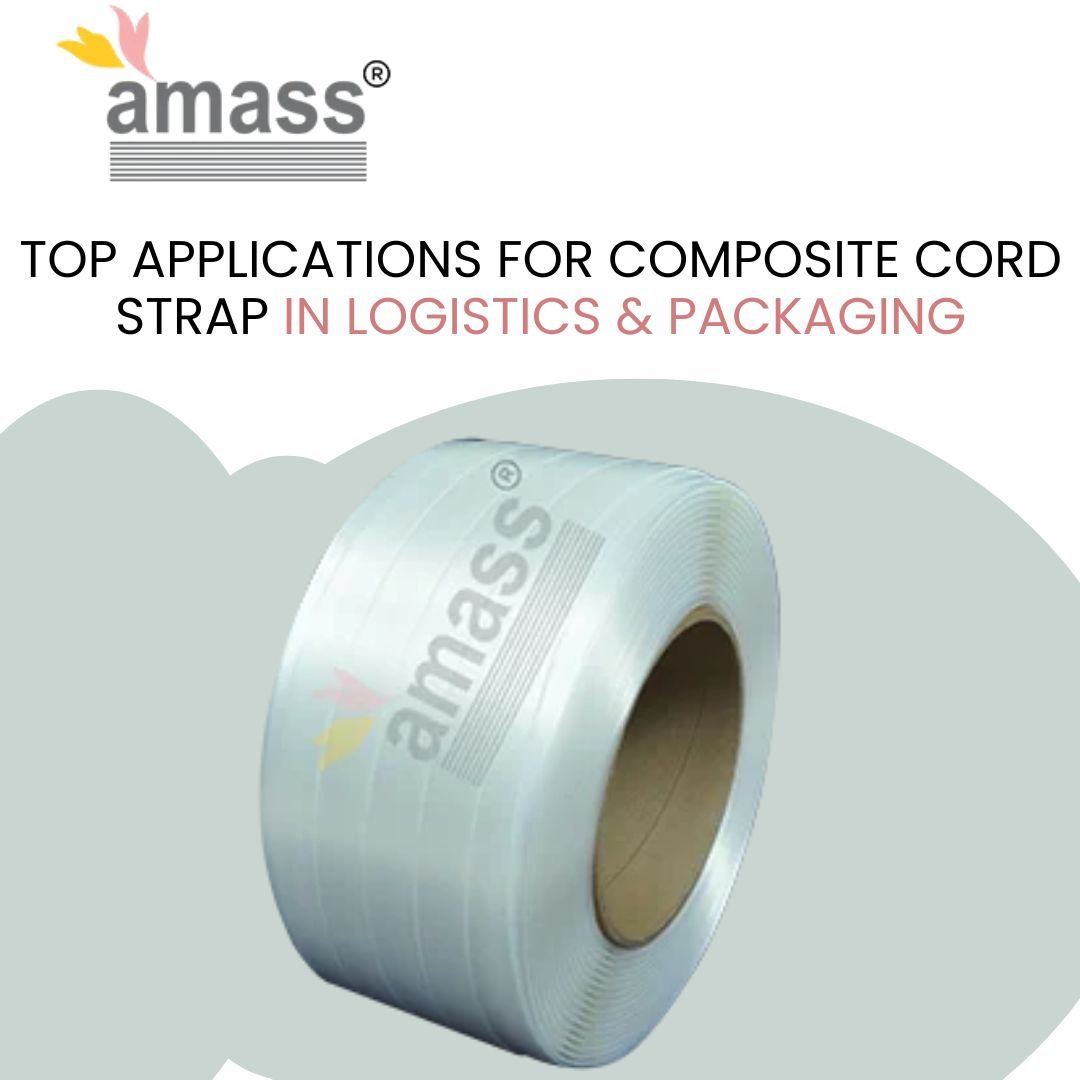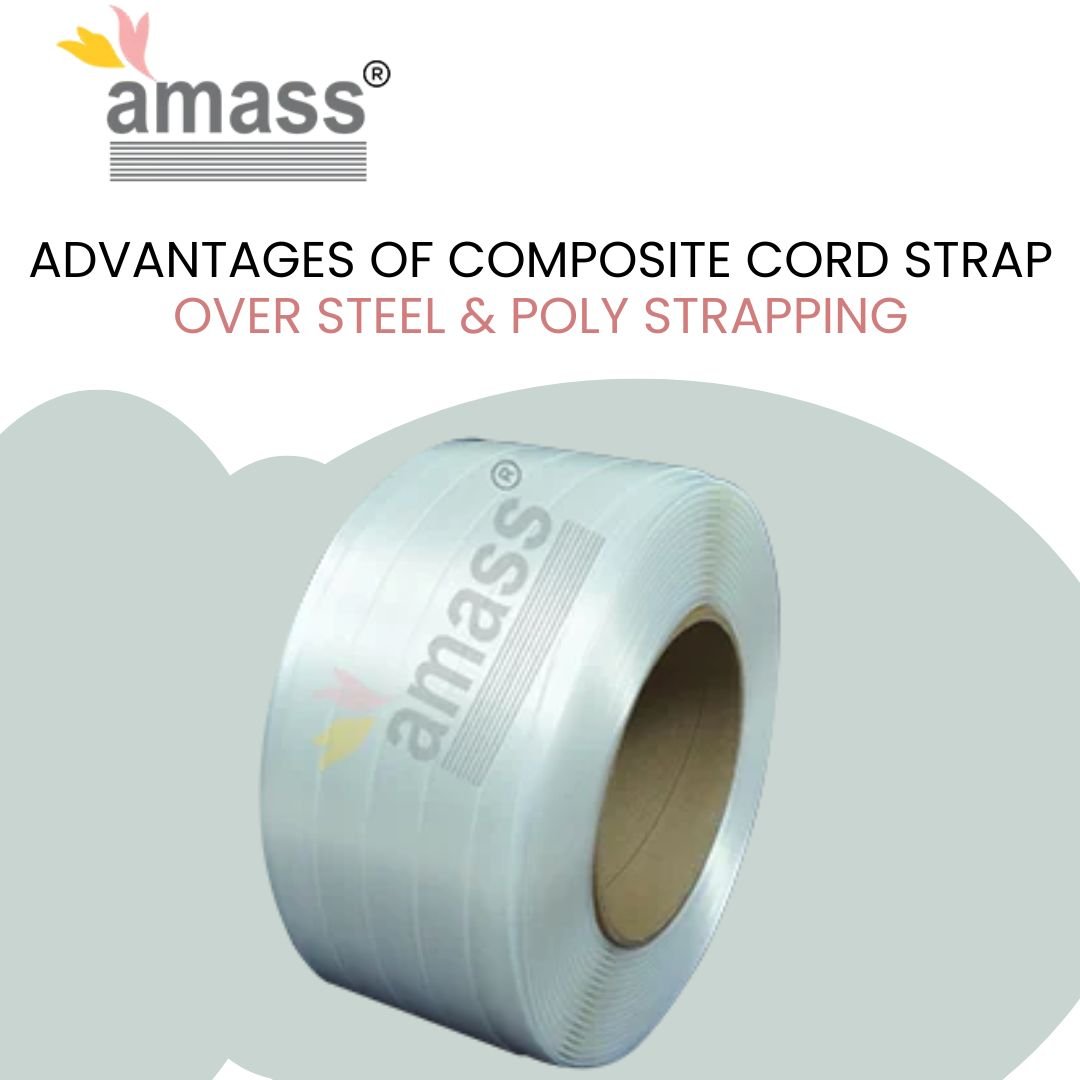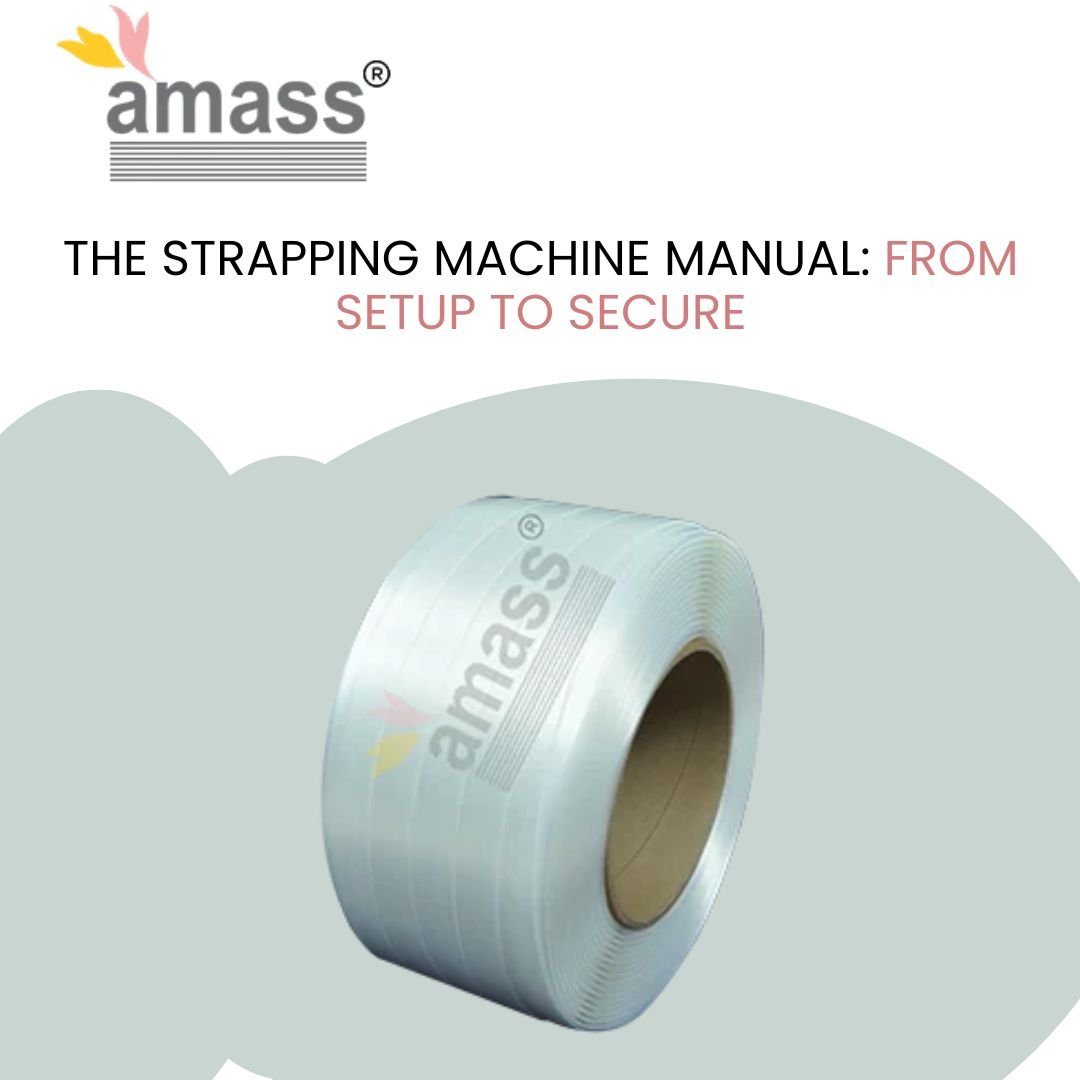Top Applications for Composite Cord Strap in Logistics & Packaging

Handling Common Issues with Composite Cord Straps
October 14, 2025
PET Strap Serrated Seals vs Smooth Seals: Which Is Better for Your Packaging?
October 16, 2025Introduction
Logistics operations lose up to 12% of packaged goods annually due to inadequate load securing methods that fail under stress, vibration, or weather exposure. Composite cord straps prevent this damage across applications from heavy machinery transport to maritime container shipping while cutting strapping costs by 30-50% compared to steel alternatives. The global composite strapping market reached USD 2.18 billion in 2024 and continues growing at 7% annually as industries prioritize durability, safety, and cost efficiency. This article details where composite cord straps deliver maximum value in logistics and packaging, what specific advantages they bring to each application, and which industries benefit most from switching to polyester-based strapping systems.
Securing Palletized Goods
Composite cord straps stabilize palletized loads for warehousing, trucking, and rail transport where shifting cargo creates handling delays and product damage. The bundling segment alone accounts for USD 230 million in annual polyester strap sales due to universal demand for secure cargo across supply chains. Unlike rigid steel straps, composite material conforms to irregular pallet shapes and absorbs vibrations during transit.
The elasticity in polyester fibers maintains consistent tension even when loads settle or shift during multi-stop deliveries. This tension retention proves critical for stackable pallets where slight movement in bottom layers compromises entire shipment stability. Composite straps also allow retensioning at distribution points—a capability steel straps lack.
Heavy-duty applications involving machinery parts, metal components, or building materials benefit from composite straps rated between 650 kg and 2,100 kg breaking strength. The shock absorption properties protect fragile items positioned on shared pallets with heavier goods.
Container and Freight Shipping
Maritime and intermodal shipping demands strapping that withstands saltwater exposure, temperature extremes, and constant motion from waves and engine vibration. Composite straps resist corrosion and maintain structural integrity in conditions that cause steel to rust within months. The United States alone conducts USD 1.4 trillion in exports and USD 2.4 trillion in imports annually, creating massive demand for reliable cargo securing solutions.
Inside shipping containers, composite straps secure crates, bundled steel coils, ceramic tiles, glass sheets, and lumber stacks for international voyages lasting weeks. The material’s UV resistance prevents degradation during outdoor storage at ports or construction sites. Containers experience rough seas, sudden stops, and vertical loading forces—composite straps’ flexibility absorbs these impacts without transferring damage to cargo.
The cost efficiency matters more in maritime applications where steel straps require replacement after single use due to corrosion, while composite alternatives support multiple shipments when properly inspected.
Construction and Building Materials
Construction sites bundle bricks, timber, concrete blocks, steel rods, pipes, and glass panels with composite straps rated for outdoor exposure and heavy loads. Building materials often sit exposed to weather for extended periods before use—composite straps’ resistance to moisture, UV rays, and temperature fluctuations prevents premature failure.
Timber bundling presents specific challenges because wood expands and contracts with humidity changes. Steel straps can’t adjust to these dimensional shifts and either break from excessive tension or loosen dangerously. Composite straps accommodate wood movement through their elastic properties and support retensioning when lumber dries out during storage.
The construction industry values composite straps’ safety profile since workers handle strapping without protective equipment concerns required for steel’s sharp edges and recoil hazards. Irregular building materials like pipe bundles and scaffolding components secure better with flexible strapping that conforms to awkward shapes.
Machinery and Equipment Packaging
Industrial equipment manufacturers strap engines, automotive parts, metal fabrications, and machinery during long-distance shipping to prevent movement that misaligns precision components. Composite straps rated for 1-5 ton loads handle heavy equipment securing while providing the shock absorption essential for sensitive mechanical assemblies.
The packaging application segment within polyester strapping addresses bundling requirements for spare parts, mechanical components, and assembled machinery. These items often ship internationally, requiring straps that maintain tension across temperature zones from -30°C to 140°C.
Equipment crating involves corner protections and composite straps working together to distribute pressure evenly across wooden crate surfaces. The combination prevents strap cutting into soft wood while maintaining secure hold on the equipment inside.
Export and International Logistics
International trade growth directly fuels composite strap adoption—India’s manufacturing exports reach USD 1.2 billion in 2025, with polyester strap demand growing at 8.5% CAGR as the fastest rate in Asia-Pacific. Export packaging must meet destination country standards for cargo securing while surviving multi-modal transport through trucks, rail, ships, and warehouses.
Composite straps cost 30-50% less than steel while meeting international cargo securement standards for breaking strength and weather resistance. This cost advantage compounds across high-volume export operations shipping thousands of containers annually.
The reusability factor matters in reverse logistics where packaging returns to origin points for reuse. Composite straps inspected for damage support multiple export cycles, unlike steel that corrodes or work-hardens after initial use.
Agriculture and Forestry
Hay bales, log bundles, lumber stacks, and agricultural products require strapping that tolerates outdoor storage, moisture from rain or snow, and irregular load shapes. Forestry operations bundle logs with diameters varying by 20-30%, creating uneven pressure points where steel straps cut into bark or snap under tension.
Composite straps’ flexibility distributes pressure evenly across irregular timber surfaces while maintaining tension as logs settle. The weather resistance proves essential since forestry products often sit in outdoor yards for weeks before processing.
Agricultural packaging for baled products benefits from composite straps’ lightweight nature, which reduces total shipping weight for price-sensitive commodity transport. The material doesn’t rust when exposed to fertilizers, pesticides, or moisture common in agricultural environments.
Consumer Goods and Retail Distribution
Warehouse storage and retail distribution centers use composite straps for bundling boxed consumer goods, appliances, electronics, and packaged foods requiring damage-free handling. E-commerce growth drives packaging demand—the sector requires 15.22% annual growth in plastic strapping through 2034 as online retail expands.
Automated strapping machines in high-volume distribution centers accommodate composite straps’ consistent thickness and flexibility for rapid application speeds. The material won’t damage corrugated packaging or product surfaces, preventing returns from strap-related cosmetic damage.
Consumer goods often involve mixed-product pallets where weight varies across the load. Composite straps adjust to these variations through elastic properties that steel can’t match.
Specialty Industrial Applications
Textile Industry
Fabric rolls, carpet bundles, and textile products require non-marking straps that won’t stain or damage materials during storage and shipping. Composite straps’ smooth polymer coating prevents snags or color transfer onto fabrics.
Chemical and Ceramic Manufacturing
Chemical-resistant composite straps handle containers and bundled products in manufacturing environments where steel corrodes from exposure to acids, bases, or industrial solvents. Ceramic tile packaging uses composite straps to prevent edge damage from excessive pressure.
FAQs
Q: Which industries use composite cord straps most heavily?
A: Logistics and warehousing account for 29% of strapping materials market share, followed by construction, manufacturing, and food and beverage sectors. The composite strapping market specifically reached USD 2.18 billion in 2024, driven by expansion in logistics, export packaging, and heavy industry applications.
Q: What breaking strength do I need for different applications?
A: Light to medium palletized goods require 400-650 kg rated straps, heavy building materials and machinery need 650-1,200 kg, and extreme applications like steel coil bundling use 1,500-2,100 kg rated composite straps. Always match strap rating to maximum expected load weight with 50% safety margin.
Q: How does composite strap performance compare to steel in real-world use?
A: Composite straps deliver equivalent securing force at 30-50% lower cost while eliminating corrosion issues, reducing injury risks, and supporting reuse across multiple shipments. Steel maintains advantages only for extremely hot loads or cargo with sharp edges that might cut polyester fibers.
Q: Can composite straps work with automated strapping equipment?
A: Yes, composite cord straps integrate with pneumatic and battery-powered tensioning tools for high-volume operations. The consistent thickness and flexibility make them suitable for automated strapping machines in distribution centers processing hundreds of packages hourly.
Q: What maintenance do composite straps require during storage?
A: Store straps in dry conditions away from direct sunlight to prevent UV degradation on non-resistant coatings. Keep materials at temperatures between 0°C and 40°C to maintain polymer coating flexibility. Inspect stored straps quarterly for coating damage, discoloration, or brittleness before use.
Conclusion
Composite cord straps address securing requirements across logistics operations valued at USD 2.18 billion globally, with 7% annual growth driven by e-commerce expansion, international trade increases, and manufacturing sector demands. Applications span from palletized goods and container shipping to construction materials, machinery packaging, and specialty industrial uses where corrosion resistance and shock absorption prove essential. The 30-50% cost advantage over steel combined with reusability and enhanced safety makes composite straps the preferred solution for operations prioritizing both performance and budget efficiency.
Request application-specific recommendations to identify the optimal strap specifications for your logistics operations.
Amass Strap offers composite cord strapping from 13mm to 32mm wide with breaking strengths of 400 kg to 2,300 kg for diverse logistics and packaging needs, from light consumer goods to heavy machinery. Our straps are available in weather-resistant, UV-stabilized, and chemical-resistant formulations, all meeting international cargo securement standards with certified system breaking strengths.
Visit amass-strap.com to access our application selection guide or schedule a consultation with our logistics team to analyze your specific securing requirements and recommend cost-optimized strapping solutions matched to your operational demands.




